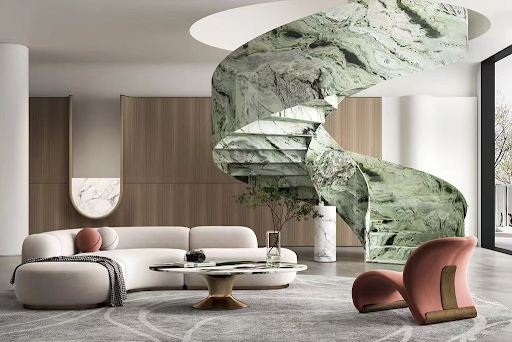The incorporation of stone stairs into your home not only enhances its aesthetic appeal but also guarantees longevity and durability. Renowned for their robustness, ease of maintenance, and timeless elegance, stone stairs contribute significantly to the overall worth of your home. Whether indoors or outdoors, these architectural features have been a staple in historic sites, upscale homes, parks, and hillside developments.
Benefits of Stone Stairs
Stone stairs offer exceptional durability, surpassing alternatives like wood or vinyl. Resistant to scratches, chips, and wear, they endure harsh weather conditions without compromising on quality. Their longevity ensures a lasting investment, providing a staircase that stands the test of time. Additionally, their non-slippery surface makes them a safe choice for high-traffic areas. The aesthetic elegance of stone stairs transcends time, seamlessly blending durability with natural beauty. The intricate textures and colour variations of each step create a rustic charm that delivers a dramatic architectural statement, instantly elevating any space.
Types of Stone for Stairs
Different types of stone, such as igneous, sedimentary, and metamorphic, offer various characteristics based on their formation. Granite, an igneous stone, is formed from cooled lava or magma. Limestone, a sedimentary stone, results from the compaction of various minerals. Marble, a metamorphic stone, undergoes alteration due to intense heat or pressure.
Choosing the perfect stone for stairs involves considering factors like durability, aesthetics, and safety. Materials like granite or marble are ideal for longevity and elegance, and ensuring a fine texture or polish helps prevent slips. Each stone type has unique pros and cons, requiring careful consideration based on individual preferences and requirements.
Stone Stair Designs
Traditional and modern stair designs cater to diverse architectural preferences. Traditional designs often feature classic aesthetics with intricately carved wooden balusters, inviting handrails, and artisan newel posts, exuding timeless elegance. On the other hand, modern designs incorporate materials like glass, steel, and wood for a minimalist yet stylish look, often featuring unique patterns, floating designs, and under-stair storage.
Choosing the right design is crucial, reflecting personal taste and style while impacting comfort and functionality. Consider lifestyle needs, practicality, and aesthetics to ensure the chosen design complements the overall structure of the house.

Installation Process of Stone Stairs
Before installing stone stairs, thorough pre-installation measures are essential. This includes system compatibility checks, data backups, software updates, and disabling security software that may interfere with the installation process. The installation itself involves downloading the software, running the installer, agreeing to terms and conditions, selecting the installation directory, and completing the process with a system reboot if necessary.
Post-installation care is crucial for maintaining optimal functionality and extending the lifespan of stone stairs. Routine inspections, updates, cleaning, and prompt repairs in case of malfunctions are integral to ensuring a lasting and reliable installation.
Costs and Economic Factors
While stone stairs come with associated expenses such as materials, labour, maintenance, and potential repairs, the choice of stone significantly impacts overall costs. Materials like granite, marble, or limestone may have different price points, influencing the economic considerations of the project.
Despite initial costs, stone stairs offer long-term economic benefits due to their durability and minimal maintenance requirements. The timeless appeal enhances property value, resulting in substantial savings and investment gains over time.
Stone Stairs Safety
Ensuring the safety of stone stairs is paramount, especially considering their potential slipperiness. Nonslip treatments can be applied to the surface, and secure handrails provide added stability. Regular inspections for cracks or damage are crucial to maintaining user safety, making these architectural features not just aesthetically pleasing but also secure for everyday use.

